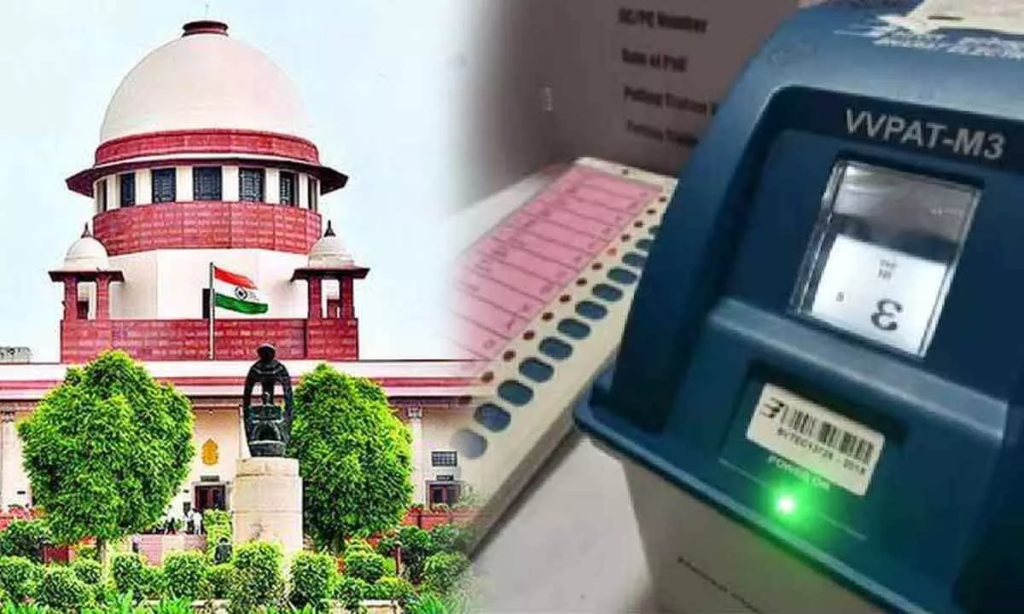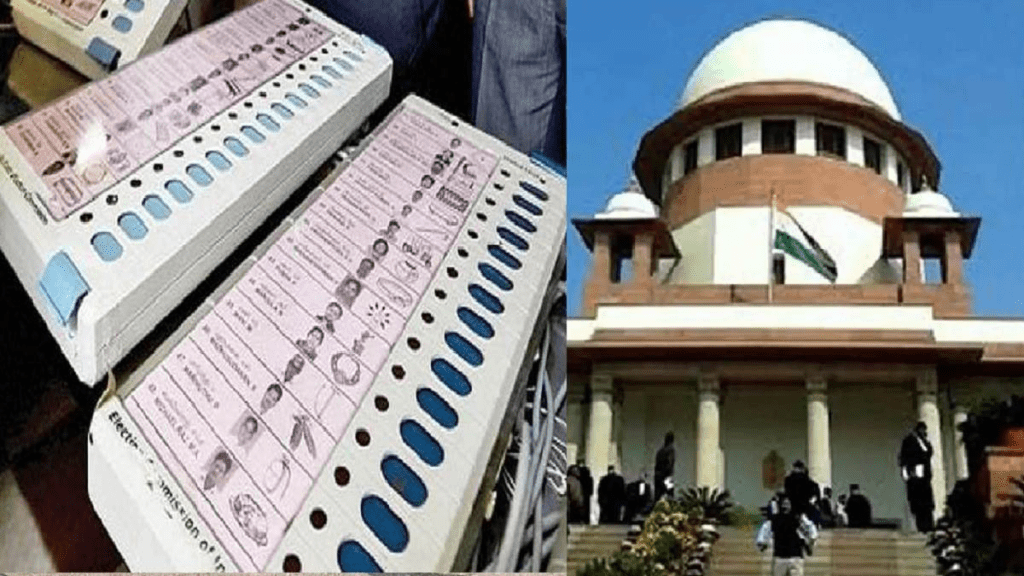सुप्रीम कोर्ट ने कहा ईवीएम ने बूथ कैपचरिंग को खत्म किया

सुप्रीम कोर्ट ने शुक्रवार को इलेक्ट्रॉनिक वोटिंग मशीन से छेड़छाड़ की आशंका व संदेश को निराधार बताया है और कहा कि दोबारा से मतपत्र से मतदान करने की प्रणाली पर वापस लौटने से पिछले कुछ समय में चुनाव की स्थिति पहले जैसे हो जाएगी | शीर्ष अदालत ने कहा कि ईवीएम की जगह मत पत्र पर वापस लौटना उस दौर में जाना होगा जब भूथ कैपचरिंग होती थी |
सिर्फ अदालत ने ईवीएम में दर्ज 100 फ़ीसदी मतों को वीवीपैट से मिलान करने और फिर से मत पत्र से चुनाव कराने की मांग को लेकर दाखिल याचिका को खारिज करते हुई यह टिप्पणी की है |
जस्टिस संजीव खन्ना और दीपंकर दत्ता की पीठ ने गैर सरकारी संगठन एसोसिएशन फॉर डेमोक्रेटिक रिफॉर्म औरअन्य की यचिकाओं को खारिज करते हुए सहमति वाले दो अलग-अलग फैसले दिए | जस्टिस खन्ना ने अपने फैसले में कहा कि याचिकाकर्ताओं ने ईवीएम में हेर फेर या किसी भी तरह से बदलाव किए जाने का अंदेशा जताया है लेकिन इसे अस्वीकार करने में के लिए कोई समुचित आदर नहीं होने के कारण इस मांग की दावे की को खारिज किया जाता है |
ये भी पढ़ें: ईरान-पाकिस्तान का नया याराना
ईवीएम में छेड़छाड़ के पहलू पर जस्टिस खन्ना ने अपने फैसले में लिखा कि चुनाव परिणाम को बेहतर बनाने के लिए जली हुई मेमोरी में अगेये वादी फर्मवेयर को हैक करने या इसके साथ छेड़छाड़ करने की संभावना निराधार है | उन्होंने कहा याचिकाओं कर्त्ता कि इस संदेह को खारिज कर देना चाहिए कि ईवीएम को बार-बार गलत तरीके से प्रोग्राम करके किसी उम्मीदवार के पक्ष में वोटिंग रिकॉर्ड किया जा सकता है | एवीएम और मतदान प्रक्रियाविश्वसनीयता और अखंडता सुनिश्चित करने के लिए पर्याप्त जाच की जाती है
ईवीएम में वोटिंग प्रक्रिया का जिक्र
जस्टिस खन्ना ने फैसले में मतदान से लेकर मतगणना तक की पूरी प्रक्रिया का जिक्र किया और कहां की हर मतदाता को गुप्त रूप से मतदान करने की अनुमति है | किसी भी मतदाता को मतदान कक्ष में प्रवेश की तब अनुमति नहीं है, जब कोई अन्य मतदाता पहले से वहां मौजूद हो | साथ ही, मतदाता पारदर्शी खिड़की से मुद्रित वीवीपैट पर्ची देखने का हकदार है, जिसमें इस प्रत्याशी का क्रमांक और नाम चिन्ह होता है, जिसे मतदान किया है |
स्याही लगाने के बाद वोट ना दें तो वजह लिखें
फॉर्म 17 ए में विवरण दर्ज करने और उसे पर हस्ताक्षर या अंगूठी का निशान लगाने के बाद भी यदि कोई निर्वाचक वोट नहीं देता, तो पीठासीन अधिकारी को फॉर्म 17a में एक टिप्पणी करनी होगी उसके खिलाफ निर्वाचन के हस्ताक्षर या अंगूठी के निशान लेना होगा | साथ ही कहा है कि पीठासीन अधिकारी को समय-समय पर फॉर्म 17 ए में दर्ज आंकड़ों के साथ नियंत्रण इकाई में दर्ज किए गए वोटो की कुल संख्या की जांच करने की आवश्यकता होती है|
मतदान समाप्ति पर पीठ चिन्ह अधिकारी द्वारा फॉर्म 17 सी में दर्ज वोटो का लेखा-जोखा तैयार करना जरूरी होता है | गिनती मतदान उम्मीदवारों की उपस्थिति में नियंत्रण इकाई पर परिणाम बटन दबाकर की जाती है |

पांच केन्द्रो की रेंडम गिनती
संसदीय क्षेत्र के प्रति विधानसभा क्षेत्र में पांच मतदान केंद्रों की वीवीपैट पर्चिओ पर किया को रेंडम तरीके से चुना जाता है और पर्चियां को ईवीएम के मतों से मिलान किया जाता है और फिर परिणाम का मिलान नियंत्रण इकाई के इलेक्ट्रॉनिक परिणाम से किया जाता है |
साथ ही कहा गया कि आयोग की दिशा निर्देश के मुताबिक यदि मॉक पोल डेटा या वीवीपैट पर्चियां की मंजूरी न होने के कारण नियंत्रण इकाई फॉर्म 17 सी में दर्ज वोटो की कुल संख्या के बीच में कोई अंतर होता है, तो संबंधित को मुद्रित वीवीपैट पर्चियां यदि जीत के अंतर ऐसे मतदान केदो पर पड़े कुछ वोटो के बराबर या उससे काम है, तो मतदान केदो को दोबारा से गिनती की जाती है | साथ ही कहा कि ईवीएम को समय-समय पर तकनीकी विशेषज्ञ समिति द्वारा परीक्षण किया गया और इसमें कोई गलती नहीं मिली |
बार-बार संदेह चुनाव में जनता के भरोसे को काम करता है
सुप्रीम कोर्ट ने अपने फैसले में कहा कि चुनाव प्रणाली पर बार-बार संदेह और निराधार चुनौतियां यहां तक की सबूत के अभाव में भी, चुनाव मतदाताओं की विश्वास और भागीदारी को कमजोर कर सकती है| पीठ ने कहा कि बार-बार और लगातार संदेह और निशान, यहां तक की बिना सबूत के भी, विश्वास पैदा करने की विपरीत प्रभाव डाल सकती |
इससे चुनाव में मतदाताओं की भागीदारी और आत्मविश्वास कम हो सकता है, जो एक स्वस्थ और मजबूत लोकतंत्र के लिए आवश्यक है | बिना किसी ठोस आधार कीईवीएम को दी जा रही चुनौतियों वास्तव में धारणाओं और पूर्वाग्रहों को प्रकट कर सकती है |

आशंका के आधार पर सवाल उठाने की अनुमति नहीं
जस्टिस दीपंकर दत्ता ने अलग लिखे अपने फैसले में कहा कि शीर्ष अदालत ईवीएम की प्रभाव शीलता के बारे में याचिकाकर्त्ताओं और आशंकाओं और अटकलें के आधार पर आम चुनाव की पूरी प्रक्रिया पर सवाल उठाने और उसे प्रभावित करने की अनुमति नहीं दे सकती | उन्होंने कहा, कि ईवीएम अपने काम पर खरी उतरी और मतदाताओं ने इस पर विश्वास व्यक्त किया |
देश की पिछले 70 सालों में स्वतंत्रता और निष्पक्ष चुनाव कराने पर गर्व रहा है, जिसका श्रेय काफी हद तक भारत की निर्वाचन आयोग और जनता द्वारा उसे पर जताए गए विश्वास को दिया जा सकता है | उन्होंने कहा कि याचिकाकर्त्ताओं ना तो कभी यह दिखा पाए कि चुनाव में ईवीएम का इस्तेमाल निष्पक्षस्वतन्त्र चुनाव के सिद्धांत के का कैसे उल्लंघन करता है और ना ही एवं में दर्ज सभी मतों को वीवीपैंट पर्चियो के शत- प्रतिशत मिलन के अधिकार को साबित कर सके |
देश की विभिन्न अदालतो में काम से कम 40 बार ईवीएम की विश्वसनीयता को चुनौती देने वाली अर्जियां खारिज़ की जा चुकी है | शुक्रवार को चुनाव आयुक्त ने यह जानकारी दी|
आयोग के अधिकारियों ने मुख्य निर्वाचन आयुक्त राजीव कुमार को उसे टिप्पणी को भी दोहराया जिसमें उन्होंने कहा कि ईवीएम शत – प्रतिशत सुरक्षित है और राजनीतिक दल भी दिल की गहराई से जानते हैं की मशीन सही है | इससे पहले 16 मार्च को राजीव कुमार ने लोकसभा चुनाव की तारीखों की घोषणा करते हुए बताया कि करीब 40 बार ऐसी याचिका खारिज हो चुकी है |
और पढ़ें: तुष्टीकरण के आगे कांग्रेस ने टेक दिए घुटने’, बोले पीएम मोदी







